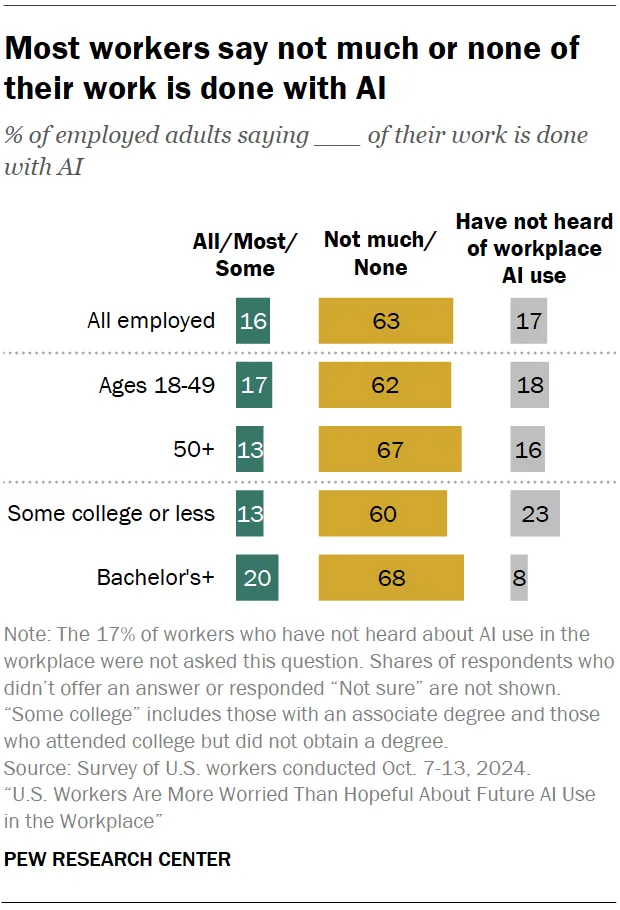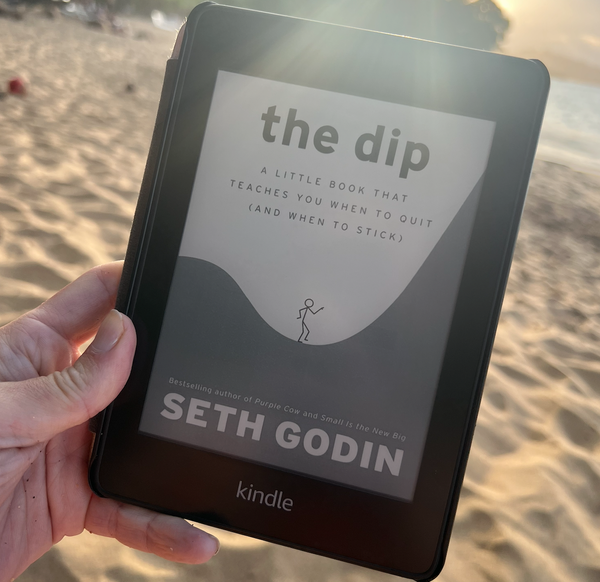You’re Not Too Late to AI: A Clear Guide to Catching Up
AI can feel overwhelming, but getting started doesn’t have to be. This guide breaks it down so you can start learning and taking action today.

A lot of people feel like they’ve already missed the boat on AI.
It’s easy to see why. Every day, new tools, research, and advancements flood the internet. It can feel like if you didn’t start months ago, there's no way you'll catch up.
In reality, AI adoption is still in the early stages. Most people are barely scratching the surface of what’s possible, and many are still figuring out the basics. If you start learning now, you can quickly catch up and even get ahead as the technologies evolve.
This article will break down:
• Why AI adoption is still early and why you’re not behind
• The three levels of AI adoption and where you stand
• A roadmap to help you start using AI effectively
AI Adoption is Still Early
Despite all the hype, most individuals and businesses are only experimenting with AI at a surface level. They use ChatGPT for quick answers or have automated small tasks, but true AI integration is rare.
The shift to AI isn’t only about using a chatbot to save time or resources. It is about how AI will reshape work, transform business operations, and create new growth opportunities.
As AI continues to improve, the gap between its capabilities and humans' ability to apply it effectively is widening.
While AI tools like ChatGPT have seen rapid adoption (reaching over 400 million weekly active users as of February 2025 according to Reuters), this still represents only about 5% of the global population.
A recent Pew Research Center survey found that only one in six U.S. workers use AI for some tasks. 63% rarely or never use it, and 17% aren’t even aware of AI in their workplace. Even among those who do, daily use is still low with just 10% of workers using AI chatbots like ChatGPT, Gemini, or Copilot every day or a few times a week, while 7% use them a few times a month (Pew Research).

Even at the enterprise level, only 1% of business leaders consider their organizations to be at a mature stage of AI deployment, despite most major companies investing in AI (McKinsey).
This means you’re not late. AI adoption is still in its infancy and the biggest opportunities are ahead. The key is starting before AI is everywhere. Now is the time to start learning, experimenting, and positioning yourself to lead as industries begin to transform.
The Levels of AI Adoption
Let's break this down. AI adoption happens in stages. Based on the data, most people today are at Stage 0 or 1, experimenting but not yet using AI in a way that truly changes how they work or operate.
That’s a massive opportunity. The sooner you start leveling up, the bigger the advantage you’ll have.
Here’s what the progression looks like:
- Stage 0 → Pre-AI Stage: Not using AI at all
- Stage 1 → AI as a Tool: Using AI for small tasks to improve efficiency
- Stage 2 → AI as a Collaborator: Transitioning AI from an efficiency tool into a thinking partner.
- Stage 3 → AI as a Business Driver: Using AI as a core driver of innovation, decision-making, and business transformation.
The goal isn’t to rush through these stages; it’s to build a strong foundation and continually expand your knowledge and understanding of what is possible.
Where do you stand today? [Check out our AI Adoption Scorecard for help assessing what stage you're at].
Moving Up the Stages: What to Focus on at Stage 1 & Stage 2
Now that you know where you stand, let’s break down what practical steps you should take to gain foundational knowledge of AI. Remember, your goal isn’t to rush through the early levels, but to build a strong base so you can continue leveling up over time.
Stage 0 → Pre-AI Stage (Not Using AI Yet)
If you’re here, that’s okay, most people still are. The key is to start small and get curious.
Your Focus:
Build AI awareness & eliminate hesitation.
Many people at this stage overcomplicate AI before even trying it. Instead of thinking of AI as something complex or intimidating, treat it like a tool you can explore.
Start Here:
- Start playing. The next time you see an AI tool (on Google, Gmail, Spotify, or another app), try it. No pressure, just explore.
- Pick one AI chatbot and ask it questions like you would Google or a friend. Try things like:
- “What’s the best way to learn about AI?”
- “Give me 3 meal ideas based on ingredients in my kitchen."
- “What’s a fun weekend activity near me?”
- Experiment with basic tasks:
- Have it explain something you’ve been curious about.
- Ask it to recommend a book or movie based on what you like.
- Have it draft a text or email in your style of voice.
Stage 1 → AI as a Tool (Small Tasks & Efficiency)
If you’re here, you’re already ahead of many people, but you’re still just scratching the surface. The goal now is to move beyond one-off tasks and start using AI more intentionally.
Your Focus:
Go from casual use to structured, consistent AI adoption.
Start integrating AI into your daily life and work in ways that create real leverage.
Start Here:
- Pick one AI platform (I recommend ChatGPT for its breadth of features, but choose what fits you best) and go deep before jumping between tools. Explore things like:
- Prompting fundamentals: Experiment with different prompts (questions, creative tasks, problem-solving) and adjust them based on responses.
- Model differences: Switch between models (e.g., GPT-4o, o1, & o3-mini) to compare responses and see how outputs change.
- Platform features: Try voice chat, search, deep research, tasks, & look at reasoning (features vary by platform & plan).
- Start learning the foundations of AI. If you don’t understand the basics, AI will feel like magic instead of a tool you can master. Start with learning things like:
- What is an LLM (large language model)?
- How does AI process and generate responses?
- What’s the difference between AI tools vs. AI agents?
- Where is AI heading next and how will it impact your industry?
- [Bonus] Ask a chatbot to customize an AI learning plan for you based on your knowledge and goals.
- Sign up for an AI newsletter to stay updated & learn consistently. At first it may feel overwhelming to keep up with, but if you consistently read one for a few weeks, you'll start to recognize the key players and industry trends. Here are a few I recommend:
- Improve your prompting. Start refining your inputs to get better, more useful AI responses. Here are a few resources to use:
- Identifying ways AI can create efficiencies. Now that you have a better grasp of AI, start brainstorming new ways it can help you work smarter.
- What’s one task you do every day that AI could assist with?
- How could AI help you process information faster through research, summaries, or analyzing data?
- What’s an area of your work where AI could help you think bigger, not just work faster?
How to Transition to Stages 2 & 3
Once you’ve built a strong foundation, AI becomes more than a tool, it becomes a collaborator and, eventually, a driver of big ideas and expanded opportunities.
At Stage 2 (AI as a Collaborator), you’ll start using AI for strategic insights, decision-making, and creative problem-solving. You’ll go beyond surface-level tasks and integrate AI into your workflows in ways that actually shift how you work.
At Stage 3 (AI as a Business Driver), AI will start shaping your opportunities. Instead of just improving your current workflows, AI will help unlock new business models, automation-driven decision-making, and competitive advantages that wouldn’t have been possible before.
If you’re ready for these levels, check out:
- AI Audit to assess where AI fits into your work and business
- AI Adoption Scorecard to see where you rank and what’s next
Hopefully now you see that AI isn’t just for the experts or early adopters, it’s for anyone willing to learn.
No matter where you are today, there’s a clear path forward. The key is to start, stay curious, and keep building.
What’s one step you’ll take this week to level up?
Want a clearer plan for using AI in your business? I offer AI & Strategy Sprints to help you identify opportunities, integrate AI into your workflows, and stay ahead of the shift.
DISCLAIMER: This content is for informational purposes only and does not constitute business, investment, legal, financial, or tax advice. Readers should conduct their own research and consult with professional advisors before making business decisions.





